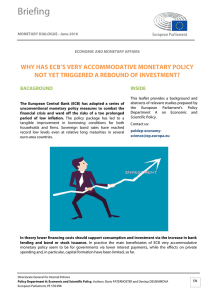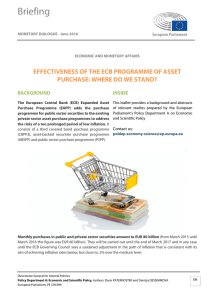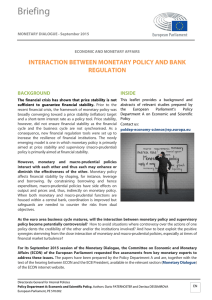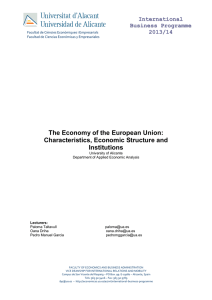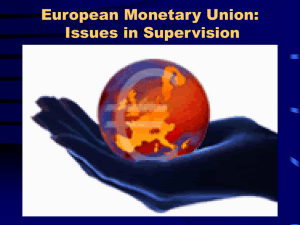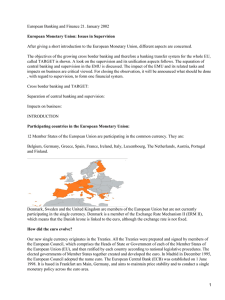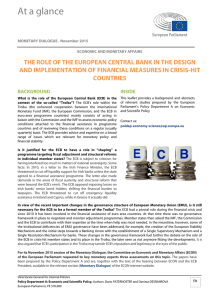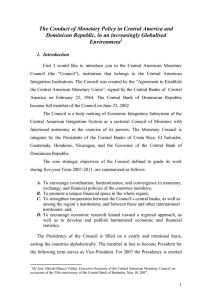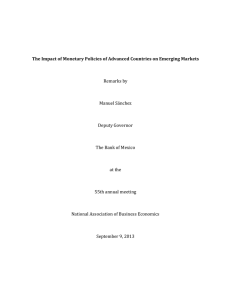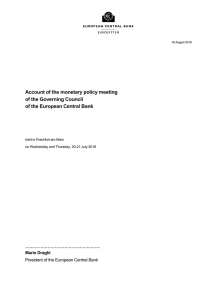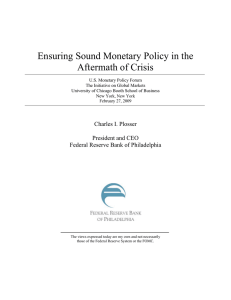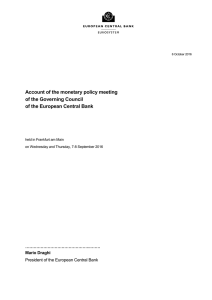Implications for the Euro area of divergent monetary policy stances
Anuncio
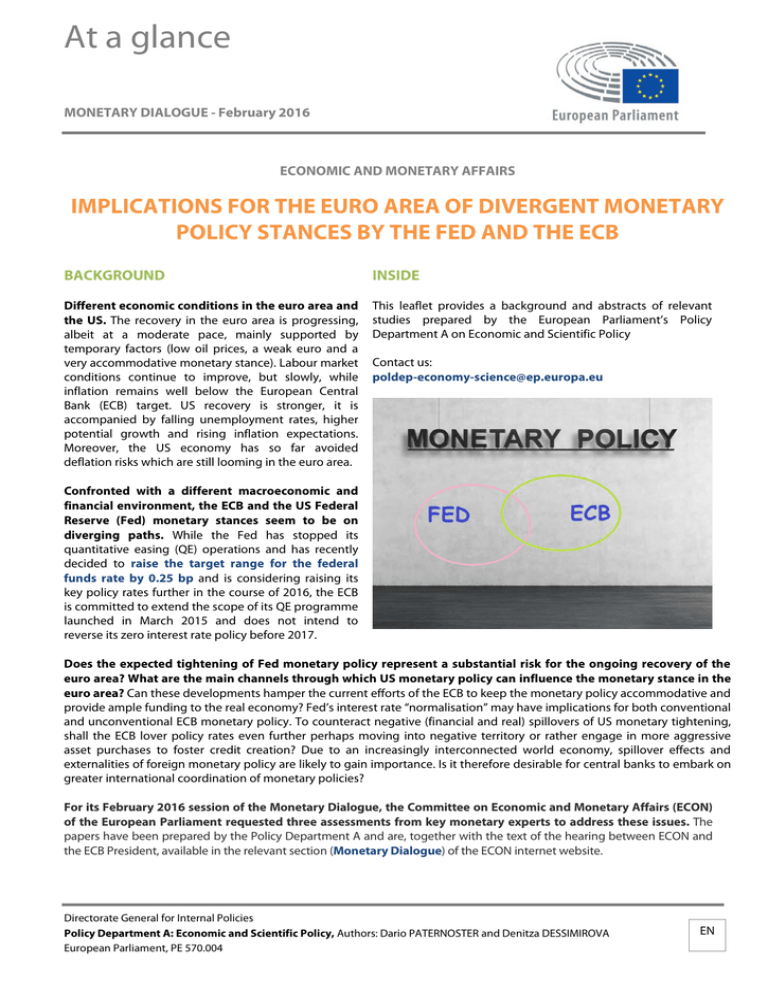
At a glance MONETARY DIALOGUE - February 2016 ECONOMIC AND MONETARY AFFAIRS IMPLICATIONS FOR THE EURO AREA OF DIVERGENT MONETARY POLICY STANCES BY THE FED AND THE ECB BACKGROUND INSIDE Different economic conditions in the euro area and the US. The recovery in the euro area is progressing, albeit at a moderate pace, mainly supported by temporary factors (low oil prices, a weak euro and a very accommodative monetary stance). Labour market conditions continue to improve, but slowly, while inflation remains well below the European Central Bank (ECB) target. US recovery is stronger, it is accompanied by falling unemployment rates, higher potential growth and rising inflation expectations. Moreover, the US economy has so far avoided deflation risks which are still looming in the euro area. This leaflet provides a background and abstracts of relevant studies prepared by the European Parliament’s Policy Department A on Economic and Scientific Policy Contact us: [email protected] Confronted with a different macroeconomic and financial environment, the ECB and the US Federal Reserve (Fed) monetary stances seem to be on diverging paths. While the Fed has stopped its quantitative easing (QE) operations and has recently decided to raise the target range for the federal funds rate by 0.25 bp and is considering raising its key policy rates further in the course of 2016, the ECB is committed to extend the scope of its QE programme launched in March 2015 and does not intend to reverse its zero interest rate policy before 2017. Does the expected tightening of Fed monetary policy represent a substantial risk for the ongoing recovery of the euro area? What are the main channels through which US monetary policy can influence the monetary stance in the euro area? Can these developments hamper the current efforts of the ECB to keep the monetary policy accommodative and provide ample funding to the real economy? Fed’s interest rate “normalisation” may have implications for both conventional and unconventional ECB monetary policy. To counteract negative (financial and real) spillovers of US monetary tightening, shall the ECB lover policy rates even further perhaps moving into negative territory or rather engage in more aggressive asset purchases to foster credit creation? Due to an increasingly interconnected world economy, spillover effects and externalities of foreign monetary policy are likely to gain importance. Is it therefore desirable for central banks to embark on greater international coordination of monetary policies? For its February 2016 session of the Monetary Dialogue, the Committee on Economic and Monetary Affairs (ECON) of the European Parliament requested three assessments from key monetary experts to address these issues. The papers have been prepared by the Policy Department A and are, together with the text of the hearing between ECON and the ECB President, available in the relevant section (Monetary Dialogue) of the ECON internet website. Directorate General for Internal Policies Policy Department A: Economic and Scientific Policy, Authors: Dario PATERNOSTER and Denitza DESSIMIROVA European Parliament, PE 570.004 EN Policy Department A: Economy and Scientific Policy PUBLICATIONS In-Depth Analysis on 'Implications for the Euro Area of Divergent Monetary Policy Stances by the Fed and the ECB ' by Andrew Hughes Hallett (School of Economics and Finance, University of St. Andrews, Scotland) In December 2015, the Fed raised US interest rates for the first time in nine years and indicated it is expected to do so four more times in 2016. The ECB, meanwhile, continued with loose monetary policy at the zero lower bound and expanded its QE programme to reduce longer dated market rates. The main consequence of these independent divergent policies in free capital mobility world would lead to more flexible dollar-euro exchange rate and larger trade imbalances, which would aggravate the conflict between goals of internal and external financial stability. The impact of these effects, however, is likely to be limited due to factors such as: (i) increased use of supply chain trade, (ii) stronger world cycle as a result of financial integration, and (iii) the small magnitude of the policy divergence. The duration of the policy difference may also be limited because of adverse effects on wider macroeconomic imbalances, which would demand a response. Internally policy divergence tends to weaken policy impact through smaller transmission and passthrough effects in the financial markets. Financial regulation could be used as an explicit policy instrument to control credit and asset markets and reduce dependence on global cycles, while allowing for tackling euro-specific problems. In-Depth Analysis on 'Implications for the Euro Area of Divergent Monetary Policy Stances by the Fed and the ECB - The Role of Financial Spillovers' by Kerstin Bernoth (Hertie School of Governance / DIW, Berlin) and Philipp J. König (DIW, Berlin) The recent interest rate increase of the Fed can be marked as the beginning of the exit of overly expansionary monetary policy in the US. A tightening of the US monetary policy may spill-over to the euro area via financial markets and financial linkages. In particular it may cause a decline in (bank) funding and an increase of European interest rates and depreciation of the euro vis-à-vis the dollar over the medium term. These developments may hamper the current efforts of the ECB to keep the monetary stance in the euro area accommodative. It is unlikely that additional (expansionary) monetary measures by the ECB could help much in containing these spill-overs. However, the ECB should work towards improving international policy coordination. This could also be in the interest of the Fed. In-Depth Analysis on 'Divergent monetary policies of the US Federal Reserve and the ECB: Implications for the euro area' by Roman Horvath (Charles University) The monetary policies of the Fed and the ECB are likely to diverge substantially over the next several years. The Fed expects to normalize its policy and increase the monetary policy rate to approximately 3% over the next 2-3 years. Meanwhile, the ECB is likely to keep the rate close to zero and implement non-standard policy measures. The resulting interest rate differential is likely to weaken the euro and make euro area exports more competitive, thereby supporting economic activity and reducing deflationary risks. However, this positive effect may be limited if the Fed’s monetary policy normalization increases financial instability in emerging market economies and if this normalization proceeds at a slower than expected pace. POLICY DEPARTMENTS MONTHLY HIGHLIGHTS The five policy departments are responsible for providing - both inhouse and external - high-level independent expertise, analysis and policy advice at the request of committees and other parliamentary bodies. They are closely involved in the work of committees which they support in shaping legislation on and exercising democratic scrutiny over EU policies. Policy departments deliver policy analysis in a wide variety of formats, ranging from studies and in-depth analyses to briefings and the Fact Sheets on the EU. This written output serves a variety of purposes by feeding directly into the legislative work of a specific committee or serving as a briefing for delegations of members. The Monthly highlights provide an overview, at a glance, of the on-going work of the policy departments, including a selection of the latest and forthcoming publications, and a list of future events. To receive this publication send an email to: [email protected] CONTACTS Policy Department A: Economic and Scientific Policy ECON - ENVI - EMPL - IMCO - ITRE - TAXE [email protected] SUPPORTING ANALYSES Access all Studies, In-depth analyses, Briefings and At a glance notes produced by the Policy Departments. All publications: www.europarl.europa.eu/supportinganalyses Disclaimer The content of this document is the sole responsibility of the author and any opinions expressed therein do not necessarily represent the official position of the European Parliament. It is addressed to the Members and staff of the EP for their parliamentary work. Reproduction and translation for non-commercial purposes are authorised, provided the source is acknowledged and the European Parliament is given prior notice and sent a copy. February 2016
